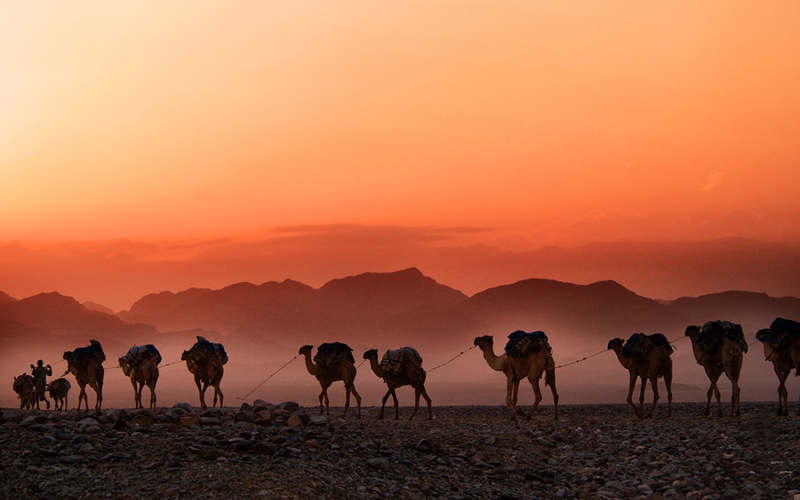The Islamic New Year, also known as Hijri New Year, marks the beginning of a new lunar year in the Islamic calendar. This significant event is observed by Muslims around the world with various cultural and religious practices. Understanding the history, significance, and customs associated with the Islamic New Year offers valuable insights into the rich traditions of the Islamic faith.
History of the Islamic New Year
The Islamic New Year, also referred to as the Hijri New Year, commemorates the migration (Hijra) of the Prophet Muhammad and his followers from Mecca to Medina in 622 CE. This pivotal event marks the beginning of the Islamic calendar. The Islamic calendar, unlike the Gregorian calendar, is a lunar calendar consisting of 12 months in a year of 354 or 355 days. As a result, the Islamic New Year moves each year by approximately 10 to 12 days in the Gregorian calendar. It was Caliph Umar ibn al-Khattab who instituted the Hijrah as the first Islamic Hijri year.
When Does the Islamic New Year Begin in 2024?
The 1st Muharram, marking the beginning of the Islamic New Year, will occur on the 7th of July 2024, subject to the sighting of the moon. Each year, the beginning of the Um al-Qura calendar (Islamic New Year) is determined by the sighting of the moon. The entire calendar, including its religious and notable days, is organized in line with the lunar calendar. Consequently, the Islamic New Year moves forward approximately 11-12 days each year while the Gregorian calendar runs on the solar year. In Islam, a new day begins at sunset. Therefore, the first day of the Islamic New Year technically begins at sunset on the 6th of July and lasts until sunset on the 7th of July 2024, subject to the sighting of the moon.
Significance of the Islamic New Year
While there are no prescribed days of worship for Muslims to observe on the 1st of Muharram, the Islamic New Year is a time for Muslims to reflect on the journey and struggles of the Prophet Muhammad and the early Muslims. The migration to Medina marked the establishment of the first Islamic state, highlighting the sacrifices and hardships endured in this pivotal moment in Islamic history. Around the Muslim world, the Islamic New Year marks the beginning of the year and inspires people to plan their annual goals and reflect on their spiritual journeys.
Customs and Traditions
Observances and Celebrations
There are no set customs or requirements for celebrating the Hijri New Year. Since Muharram is one of the sacred months Allah ordained, when Allah multiplies rewards for good acts, Muslims find it an opportune time to engage in acts of charity, voluntary prayers, fasting, and Quran recitation. The Islamic New Year is also a public holiday in many Muslim countries, and families use it as an opportunity to meet and strengthen ties with loved ones.
Fasting and Prayer
Fasting during the month of Muharram, especially on the 10th day (Ashura), is a common practice among Muslims. Although fasting on Ashura is not obligatory, it is highly recommended. Many Muslims fast to seek blessings and forgiveness. In addition to fasting, Muslims engage in increased prayer and recitation of the Quran, seeking spiritual growth and closeness to Allah.
Acts of Charity
Charity is an important aspect of the Islamic New Year. Muslims are encouraged to give to those in need, reflecting on the principles of compassion and generosity that are central to Islam. Acts of charity can range from providing food and clothing to the less fortunate, to making monetary donations to charitable organizations.
The Importance of Reflection and Renewal
The Islamic New Year is not just a time for religious observance, but also a period for personal reflection and renewal. Muslims take this opportunity to evaluate their actions over the past year, seek forgiveness for their shortcomings, and make resolutions for the future. The emphasis is on spiritual growth, self-improvement, and strengthening one’s relationship with Allah.
Virtues of the Islamic New Year
The beginning of the Islamic New Year is a time for reflection, commemoration, and gaining Allah Almighty’s nearness. One of the greatest virtues of the Islamic New Year is that it offers the opportunity for deep reflection. It’s a time to reflect on the last Islamic year in terms of decisions made, good and bad deeds, changes in character, and how well one has fulfilled the rights of Allah. This reflection serves as a basis to make improvements in life to become closer to Allah Almighty. Muslims should work to correct any shortcomings in their manners and character that may delay them from gaining Allah’s pleasure. Additionally, reflecting upon the hardships faced by the Prophet Muhammad and his family, and the sacrifices they made to ensure that Islam reached us, fosters gratitude for being Muslim and having the gift of Islam.
Send the gift of Salawat (salutations) to the Prophet Muhammad (SAW) as a gift on this special day.
Surely in the creation of the heavens and the earth, and the alternation of the night and day are signs for people of understanding, those who remember Allah while standing, sitting or reclining, and reflect in the creation of the heavens and the earth, (saying): “Our Lord! You have not created this in vain. Glory to you! Save us, then, from the chastisement of the Fire!”
Quran| 3: 190-191
The Migration (Hijrah) of the Prophet Muhammad (SAW)
The Hijrah, or migration, of the Prophet Muhammad (SAW) from Makkah to Madinah in 622 CE is a cornerstone event in Islamic history. This significant journey not only marked the beginning of the Islamic calendar but also established the foundations of the first Islamic state. The story of the Hijrah is one of faith, resilience, and divine guidance, providing profound lessons for Muslims worldwide.
During the Hijra Sharif, the Prophet (PBUH) asked his beloved cousin Imam Ali ibn Abu Talib (AS) to stay behind and return the possessions of all those who had entrusted them to him, ensuring that everything was returned to his enemies (Ibn Hashim), thus demonstrating his trustworthiness.
I saw in a dream that I was emigrating from Makkah to a land in which there are date palms, and I thought that it was Al-Yamamah or Hajar, but it turned out to be Madinah, Yathrib.
Hadith | Bukhari
The Context Leading to Hijrah
Persecution in Makkah
In the early years of Islam, the Prophet Muhammad (SAW) and his followers faced severe persecution in Makkah. The Quraysh tribe, who were the custodians of the Kaaba and influential leaders in Makkah, strongly opposed the monotheistic message of Islam. The early Muslims were subjected to various forms of abuse, including social ostracism, economic boycotts, and physical torture. Despite these hardships, the Prophet Muhammad (SAW) continued to preach the message of Islam, drawing more followers to the faith.
The Invitation from Yathrib (Madinah)
The situation in Makkah grew increasingly untenable, prompting the Prophet Muhammad (SAW) to seek a safer environment for his followers. Meanwhile, the city of Yathrib, later known as Madinah, was experiencing internal strife between its two main tribes, the Aws and the Khazraj. The people of Yathrib had heard of the Prophet Muhammad’s (SAW) wisdom and leadership and believed he could mediate their conflicts. They extended an invitation to the Prophet and pledged their support and protection.
Read more about The Migration (Hijrah) of the Prophet Muhammad (SAW)
The Preparations for Hijrah
The Pledges of Aqabah
Before the Hijrah, two significant meetings took place at Aqabah, a location near Makkah. These meetings involved representatives from Yathrib who pledged their allegiance to the Prophet Muhammad (SAW) and promised to support and defend him and his followers. These pledges, known as the First and Second Pledges of Aqabah, were crucial in securing a safe haven for the Muslims in Yathrib.
The Plan to Migrate
With the assurances from Yathrib, the Prophet Muhammad (SAW) began planning the migration. He instructed his followers to leave Makkah quietly and make their way to Yathrib in small groups to avoid drawing the attention of the Quraysh. The Prophet himself stayed behind, waiting for the right moment to undertake the journey.
The Journey of Hijrah
The Night of the Migration
The Quraysh, aware of the Prophet’s (SAW) intentions, plotted to assassinate him. To foil their plans, the Prophet Muhammad (SAW) asked his cousin, Ali ibn Abi Talib (RA), to sleep in his bed, thereby creating the illusion that he was still in his house. That night, the Prophet Muhammad (SAW) and his close companion, Abu Bakr (RA), slipped out of Makkah and headed towards a cave on Mount Thawr to hide from their pursuers.
The Cave of Thawr
The Prophet Muhammad (SAW) and Abu Bakr (RA) stayed in the cave of Thawr for three days. During this time, the Quraysh intensively searched for them but were unable to find their hiding place. Legend has it that a spider spun a web at the entrance of the cave, and a pigeon laid eggs there, leading the pursuers to believe that no one could have entered the cave recently.
The Journey to Madinah
After the search subsided, the Prophet Muhammad (SAW) and Abu Bakr (RA) continued their journey to Madinah. They traveled by night and rested by day to avoid detection.Along the way, a guide who knew the desert routes well supported them. They faced challenges throughout their journey, but they persevered with faith and determination.
The Arrival in Madinah
The Welcome in Quba
The Prophet Muhammad (SAW) and Abu Bakr (RA) first arrived in the village of Quba, on the outskirts of Yathrib, where they were warmly welcomed by the local Muslims. The Prophet spent a few days in Quba and laid the foundation of the first mosque, known as Masjid Quba, before proceeding to the city of Madinah.
Entry into Madinah
The arrival of the Prophet Muhammad (SAW) in Madinah was met with great joy and celebration. The people of Madinah, both Muslims and non-Muslims, greeted him with open arms. The Prophet’s camel, Qaswa, chose the location where the Prophet would reside and where the Masjid an-Nabawi (the Prophet’s Mosque) would be built. This event marked the beginning of a new chapter for the Muslim community.
The Significance of Hijrah
Establishment of the Islamic State
The Hijrah was not just a migration but the establishment of the first Islamic state. In Madinah, the Prophet Muhammad (SAW) implemented a constitution, known as the Constitution of Madinah, which outlined the rights and duties of all citizens, including Muslims, Jews, and other tribes. This constitution established principles of justice, equality, and mutual cooperation.
Brotherhood Between Muhajirun and Ansar
The Hijrah fostered a strong sense of brotherhood between the Muhajirun (the emigrants from Makkah) and the Ansar (the helpers from Madinah). The Ansar shared their homes and resources with the Muhajirun, creating a unified and supportive community. This bond of brotherhood is a testament to the Islamic values of solidarity and compassion.
Beginning of the Islamic Calendar
The Hijrah marks the beginning of the Islamic lunar calendar. The first year of this calendar, known as 1 AH (Anno Hegirae, “in the year of the Hijrah”), commemorates this significant event. The Islamic calendar is used to determine the dates of religious observances, such as Ramadan and Hajj, and serves as a constant reminder of the Hijrah’s importance.
Lessons from the Hijrah
Faith and Trust in Allah
The Hijrah teaches Muslims the importance of having unwavering faith and trust in Allah. Despite dangers and uncertainties, Prophet Muhammad (SAW) and his followers trusted Allah to protect and guide them.
Resilience and Perseverance
The challenges faced during the Hijrah highlight the virtues of resilience and perseverance. The Prophet Muhammad (SAW) and his companions endured hardships with patience and determination, setting an example for Muslims to remain steadfast in their faith in the face of adversity.
Community and Brotherhood
The Hijrah underscores the significance of community and brotherhood in Islam. The strong bonds formed between the Muhajirun and the Ansar demonstrate the importance of mutual support, cooperation, and compassion within the Muslim community.
Historical Context of Hijrah Sharif
The migration from Makkah to Madinah, known as Hijrah Sharif, occurred during a time of intense persecution of Muslims in Makkah. The Prophet Muhammad (SAW) and his followers faced severe opposition from the Quraysh tribe, who were staunch opponents of the monotheistic message of Islam. Growing hostility prompted Prophet Muhammad (SAW) to seek a safer place for Muslims to practice freely.
The Establishment of the First Islamic State
The arrival of the Prophet Muhammad (SAW) in Madinah marked the beginning of a new era in Islamic history. The Muslim community in Madinah welcomed the Prophet and pledged their allegiance to him. This event is significant because it resulted in establishing the first Islamic state, where Muslims implemented principles of justice, equality, and community welfare under the guidance of Islamic teachings.
The Hijri Calendar
The Hijrah Sharif is so significant that it marks the beginning of the Islamic lunar calendar, known as the Hijri calendar. The Hijri calendar was initiated during the leadership of the second Caliph, Umar ibn al-Khattab, to commemorate this monumental event. The first year of the Hijri calendar corresponds to the year 622 CE in the Gregorian calendar. This calendar is used by Muslims worldwide to determine the dates of religious events and observances.
| Name | Arabic | Meaning |
| al-Muḥarram | ٱلْمُحَرَّم | sacred |
| Ṣafar | صَفَر | void |
| Rabīʿ al-ʾAwwal/Rabīʿ al-ʾŪlā | رَبِيع ٱلْأَوَّل / رَبِيع ٱلْأُولَىٰ | the first spring |
| Rabīʿ ath-Thānī/Rabīʿ al-ʾĀkhir | رَبِيع ٱلثَّانِي / رَبِيع ٱلْآخِر | the second/last spring |
| Jumādā al-ʾAwwal/Jumadā al-ʾŪlā | جُمَادَىٰ ٱلْأَوَّل / جُمَادَىٰ ٱلْأُولَىٰ | the first when land dries out |
| Jumādā ath-Thāniyah/Jumādā al-ʾĀkhirah | جُمَادَىٰ ٱلثَّانِيَة / جُمَادَىٰ ٱلْآخِرَة | the second/last when land dries out |
| Rajab | رَجَب | respect/honor |
| Shaʿbān | شَعْبَان | scattered |
| Ramaḍān | رَمَضَان | burning heat |
| Shawwāl | شَوَّال | raised |
| Dhū al-Qaʿdah | ذُو ٱلْقَعْدَة | truce |
| Dhū al-Ḥijjah | ذُو ٱلْحِجَّة | pilgrimage |
Significance of Hijrah Sharif
Hijrah Sharif holds immense significance for Muslims for several reasons:
- Spiritual Renewal: The Hijrah represents a journey of faith and resilience. It reminds us of the early Muslims’ sacrifices to preserve and spread Islam.
- Community and Brotherhood:The Muslim community in Madinah exemplifies values like brotherhood, solidarity, and cooperation. The Muhajirun (emigrants from Makkah) and the Ansar (helpers from Madinah) formed a strong bond of unity and support.
- Foundation of Islamic Governance: The first Islamic state in Madinah upheld justice, compassion, and divine guidance. It set a precedent for Islamic governance and societal organization.
- Commemoration of Sacrifice: The Hijrah prompts Muslims to reflect on hardships faced by Prophet Muhammad (SAW) and his companions. It encourages believers to stay strong in faith and make sacrifices for their beliefs.
Lessons from Hijrah Sharif
The story of Hijrah Sharif offers several timeless lessons for Muslims:
- Faith in Adversity: Despite facing severe persecution, the Prophet Muhammad (SAW) and his followers maintained unwavering faith in Allah. Their trust in divine support and guidance is a powerful example of faith in adversity.
- Leadership and Vision: Prophet Muhammad (SAW) showed exceptional leadership by planning migration and establishing a just community in Madinah.
- Importance of Community: The bonds between Muhajirun and Ansar emphasize community support, cooperation, and mutual aid in achieving shared goals.
- Strategic Planning: The Hijrah’s planning and execution highlight the importance of strategic preparation in overcoming challenges.

The Significance of 1st Muharram in Islam
1st Muharram is significant as it marks the start of the Islamic lunar year, known as the Hijri New Year. This day marks a pivotal event in Islamic history: the Prophet Muhammad’s (SAW) migration from Makkah to Madinah. Understanding the events and importance of 1st Muharram provides insight into the Islamic faith and its historical roots.
Historical Context of 1st Muharram
1st Muharram marks the first day of the Islamic lunar calendar, also known as the Hijri calendar. The second Caliph, Umar ibn al-Khattab, initiated this calendar to commemorate the migration (Hijrah) of Prophet Muhammad (SAW) from Makkah to Madinah in 622 CE.The establishment of the Hijri calendar was a significant milestone in Islamic history as it provided Muslims with a unique calendar system based on the lunar cycle.
Conclusion
The Islamic New Year, rich in history and significance, is a profound time for Muslims around the world. It offers an opportunity for spiritual reflection, renewal, and recommitment to the values of Islam. By engaging in Islamic New Year customs, Muslims strengthen faith and unity in the global Muslim community.

